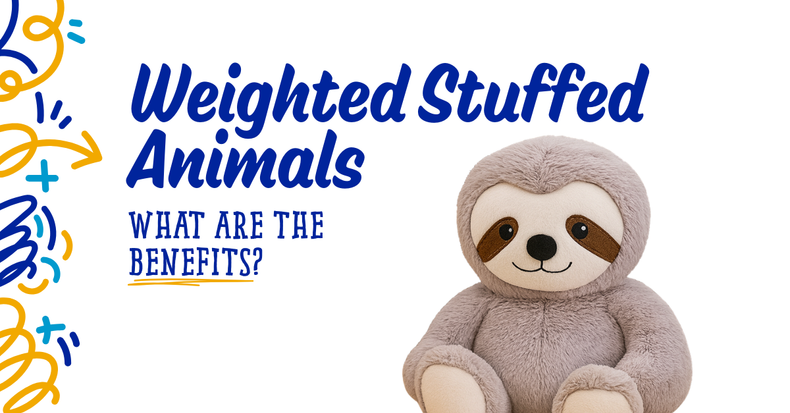Some kids find it hard to settle during class or homework. Others feel on edge in noisy, busy spaces. Weighted stuffed animals and other deep-pressure tools can help some children feel calmer and more grounded, which can make focusing easier.
Below is a clear look at what these tools are, how they work, what the research says, and simple ways to use them at home or school.
What is a Weighted Stuffed Animal?
A weighted stuffed animal is a soft plush with weight sewn inside, usually a few pounds. The gentle, even pressure across the lap, chest, or shoulders provides a sensory input called deep pressure. Deep pressure has been shown to reduce arousal for some people and promote a sense of calm, which can support attention and emotional regulation.
Weighted plushies aren’t magic, and they aren’t a fit for every child. Many families and teachers use them as one tool in a broader sensory plan.
How Does Deep Pressure Help?
Deep Pressure Stimulation (sometimes called Deep Touch Pressure) activates pressure receptors in the skin and joints. Studies suggest this input can lower anxiety and support regulation for some individuals, including autistic youth and people with ADHD or sensory sensitivities. Immediate benefits reported in research include feeling calmer, less overwhelmed, and more able to attend. Results vary by person, but the direction of effect is often positive.
Much of the formal research is on weighted blankets. Systematic reviews and recent studies report improvements in sleep quality and decreases in negative emotions for many users, which aligns with the calming effect families and teachers notice in day-to-day use.
Children and caregivers in qualitative studies also describe weighted coverings as tools that help “turn down the volume” on restlessness and anxiety so daily routines feel more manageable.
What about Focus and Learning?
When a child is less anxious and more regulated, attention usually improves. Deep pressure can be one path to that calmer state. Teachers often use a weighted item during independent work, reading time, circle time, or transitions. The evidence base is mixed across different weighted tools, and not every child responds the same way, but for some students the combination of comfort, routine, and pressure input clearly helps.
A practical takeaway is to treat weighted items like any classroom support: try it, observe, and keep what helps.
Safety and Fit
A few simple guidelines keep weighted items safe and effective.
- Start light and observe. Weighted blankets are often chosen at roughly 10 percent of body weight, but that rule does not cleanly apply to plushies and lap pads. Begin with a few pounds, watch your child’s comfort and posture, and adjust. Evidence and expert summaries continue to caution that responses vary and more research is needed.
- Skip for infants and certain medical conditions. Do not use weighted products with babies or toddlers, or with anyone who cannot independently move the item. Be cautious with respiratory or cardiac conditions and consult a clinician if you are unsure.
- Use in short, purposeful windows. Think reading block, quiet work, or transition time. Rotate with other strategies like movement breaks, noise reduction, and visual schedules to avoid over-reliance. (This balanced approach reflects the mixed results seen in weighted-tool studies.)
Simple Ways to use Weighted Plushies and Lap Tools
- Reading or writing time: place a weighted animal across the lap to provide steady input without covering the whole body.
- Calm corners: keep a weighted option available with headphones and a visual timer.
- Transitions: a short, predictable “plush + breath” routine before assemblies, bus rides, or homework can lower arousal enough to start well.
These ideas align with the way families and students in studies describe using deep pressure to manage stress and restlessness.
Our Picks for Home and Classroom
Each of the options below provides deep, calming pressure in a slightly different way. You know your learners best, so choose what fits how and where they’ll use it.
Calming Weighted Stuffies, 4 lb
A friendly, huggable way to add deep pressure without overheating. Four pounds is substantial enough to feel grounding on the lap during reading or independent work, yet easy to carry from desk to calm corner. Many children prefer a plush because it looks and feels like a typical comfort item, which can make use more natural in class.
Weighted Lap Bunny, 5 lb
A lap pad shaped like a soft bunny is ideal for desks and carpet time. The even pressure can help some students sit longer and settle their bodies during lessons, especially when combined with clear work routines. Lap pads are also easy for teachers to share across students during the day.
Weighted Sensory Neck Pillow, 3 lb
Gentle pressure across the shoulders supports posture and relaxation without occupying the hands. This is helpful for read-alouds, ride-to-school time, assemblies, or after-recess cool-down.
You can build a small toolkit by pairing one of these with movement options and noise reduction. The goal is simple: less overwhelm, more learning.
Bottom Line
Weighted stuffed animals and related deep-pressure tools are not a cure-all. The research base is growing and shows benefits for many people, especially around calm and sleep, while also reminding us that not everyone responds the same way. Used thoughtfully and safely, they can be a gentle, child-friendly way to reduce overwhelm and support focus when it matters most.
Every purchase at AdaptStore helps fund AdaptAbilities programs so more people living with disabilities can grow, succeed, and belong. Choosing sensory tools here stretches your impact beyond your household or classroom.
Start shopping today!



